Rocket Languages Chinese: A Detailed and Honest Review [With Screenshots!]
What is Rocket Languages Chinese?
Rocket Chinese is the Chinese language learning course by Rocket Languages. Their aim is to help create a culturally connected world through language learning.
- what it’s for:
- Introducing language learners to the Chinese language from absolute beginner level to beginner conversations.
- languages:
- Chinese
- level:
- Absolute beginner to lower intermediate
+ PROS
- The app and website are clear and easy to use, with a nice interface and structure.
- It follows 3 levels of Chinese learning, from about a CEFR A1 to B1 level.
- The app focuses a lot on listening and pronunciation, which is great for auditory learners.
- There are lots of review options, from flashcards to pronunciation practice.
- The pronunciation games and ability to compare your voice recording to the native speaker is a great feature.
- The language and culture lessons are insightful and offer a lot of knowledge in each lesson.
- It’s a clear, structured course that will help guide you along in your Chinese learning.
- CONS
- The audio lessons are very slow, often awkward, and very long for beginners.
- It’s quite repetitive, which gets boring fast.
- The lessons don’t always flow logically and a lot of early vocab is not helpful or immediately useful to beginners. There’s a lot of wasted effort.
- Even though the emphasis is on listening and pronunciation, I found the explanation of pronunciation to be lacking.
- There isn’t a lot of diversity in the learning: each lesson is more or less the same, with the same review activities and outline.
Quick verdict: Rocket Chinese might be a better fit for those who prefer traditional, slower-paced, immersive style learning, and for auditory learners. That just isn’t me.
The Rocket Languages Chinese course, called Rocket Chinese, is one of the most well-known Chinese courses. But is it worth it? That’s what we’ll talk about in this Rocket Languages Chinese review.
Rocket Languages is a language learning course and app that was created in 2004. With 17 years under the company’s belt, it’s one of the most well-known language courses.
Search for almost any language question, and you’ll inevitably find a blog post by them about it.
That said, Rocket Languages had a bit of a reputation for spammy marketing and big issues with their languages for a while. To their credit, they listened to those critiques and launched a massive update in 2020 to address those issues.
So when Fluent in 3 Months asked me to review Rocket Languages, I thought, “Why not?” After all, after watching Shang Chi and the Legend of the Ten Rings recently, I felt very motivated to bump up Chinese on my language learning wishlist.
Table of contents
- My Level in Chinese Before I Started Testing Rocket Chinese
- What is Rocket Languages?
- Is Rocket Chinese Free?
- How Rocket Languages Works
- Interactive Audio Lessons
- Language & Culture Lessons
- Writing Lessons
- My Experience with Rocket Languages: An Honest Review
- Rocket Languages Pros and Cons
- Rocket Chinese Review Summary: 3 Stars, a Decent Course with Better Options Out There
My Level in Chinese Before I Started Testing Rocket Chinese
I started Rocket Languages with pretty much zero Chinese language knowledge. I only knew “hello,” “how are you,” and recognized the meaning of some hanzi from my Japanese studies.
That means this review is completely from the perspective of an absolute beginner in Chinese.
Most of the language learning courses I’ve reviewed, such as 90 Day Korean and Japanese Uncovered, I went into it with some or a lot of language experience. I was curious to see how Rocket Languages would help me learn Chinese with no experience.
So, let’s dive in.
What is Rocket Languages?
Rocket Languages is a language learning course and app where you can learn 13 languages. They are:
- Chinese
- Japanese
- Korean
- Spanish
- Italian
- French
- American Sign Language
- English
- German
- Hindi
- Russian
- Arabic
They aim to help you immerse yourself in the language fast through audio lessons.
Their courses focus on pronunciation, listening, culture, reading, and writing. There’s a much smaller emphasis on grammar, It’s mostly taught through Language and Culture lessons and learned through immersive study.
The courses also include a section for Survival Kit phrases and review. The Chinese course, in particular, is broken down into three levels:
- Level 1: From absolute beginner to about CEFR A1 level
- Level 2: From an A1 level to about an A2 level (upper beginner)
- Level 3: From an A2 level to about a B1 level (lower intermediate)
Is Rocket Chinese Free?
Now, is Rocket Chinese free?
No.
Although it does have a lot of free resources, such as their blogs, free lessons, language learning forum, and a free trial of their paid course.
If you decide to get the paid course, the pricing ranges from $149.95 (for level 1 only) to $449.85 (for all three levels).
But there are usually coupons and deals to get it significantly cheaper. (At the time of writing this, they have a sale going on for 42% off the total price of all levels. A great deal.)
How Rocket Languages Works
The course structure works like this: Each level is broken down into modules. Each module is broken down into about 13 lessons in 3 categories: interactive audio, language and culture lessons, and writing lessons.
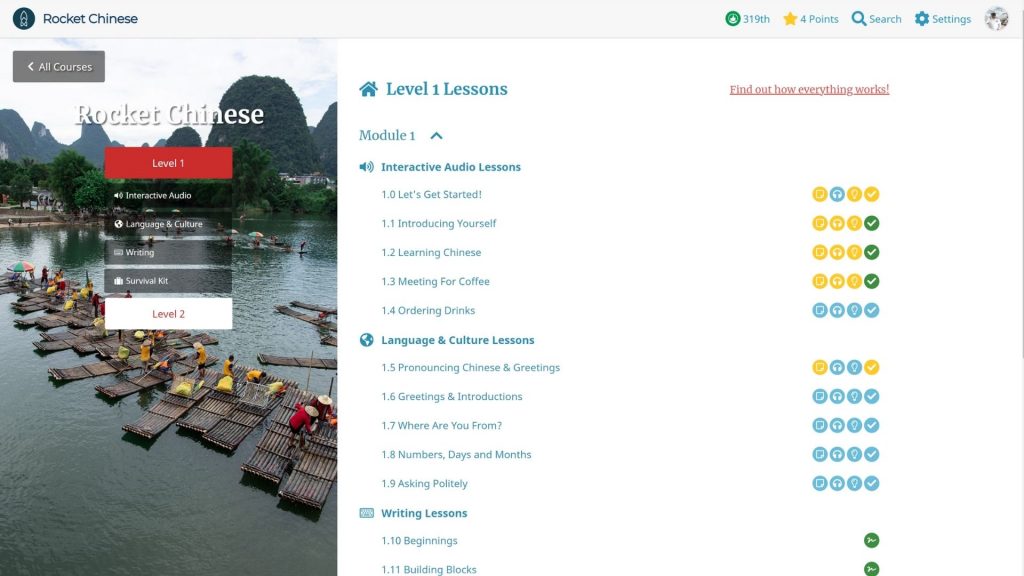
Interactive Audio Lessons
The interactive audio lessons start with a podcast-style lesson that’s about 20 – 30 minutes long. The lesson features an English speaker as the host and a native Chinese speaker.
The lessons start with an introduction, then go into a short dialogue.
The dialogue is followed by a line-by-line breakdown of the sentences and new words, with lots of pause time for you to repeat after the speaker.
The interactive audio lessons aren’t bad. I like that they emphasize repeating and pronunciation.
That said, I found them pretty boring. The pauses were too long, and lots of awkward dialogue that dragged out the lessons.
If you’re on the web version, the audio box includes the line-by-line audio for you to read, and you can click on it to skip to that line.
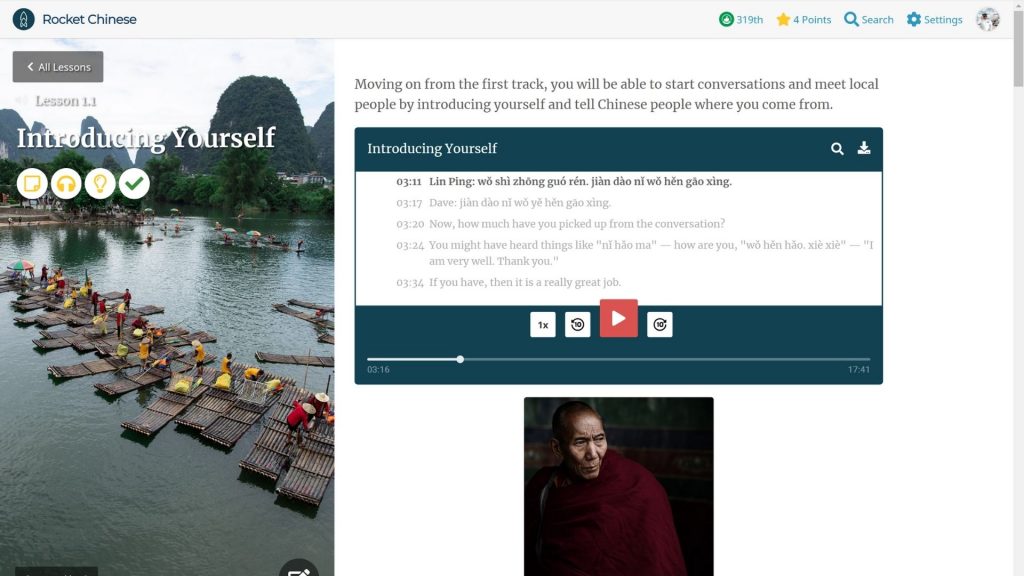
I did that a lot to skip past the too-long pauses and filler, and eventually ended up mostly skipping the audio lessons altogether. I mainly used the next two parts of the lesson: the Play It conversation review and the Extra Vocabulary section.
I felt like the audio lessons themselves taught very little for how long they were. And to be frank, listening to a 30-minute lesson as an absolute beginner was a bit daunting.
Besides that, despite the emphasis on repeating and pronunciation, I found that the lessons lacked actual pronunciation tips. It’s mostly a shadowing exercise to help you learn Chinese tones and pronunciation.
Even stranger, the English host spoke English slowly, while the Chinese was at a more normal speed.
These lessons may be fine for those who enjoy a more traditional approach to language learning and a slower pace, but it feels outdated.
Exercises and Review
After the interactive audio lesson, there are several ways to review.
- Play It!: A line-by-line practice of the lesson’s dialogue where you can play as either speaker and record yourself saying the dialogue. On the computer, you can playback your audio to hear how you did. Their program gives you a grade ranking (up to 100, being “perfect”). But the playback of your own audio feature is not available on mobile web or the app.
- Extra Vocabulary: A list of the lesson dialogue vocabulary as well as other helpful or related vocab.
- Expert Tip: A language learning tip for improving your studies.
- Rocket Reinforcement Activities: flashcards, listen-and-repeat, translation and pronunciation, lesson quiz, and hanzi (Chinese characters) practice.
This is the best part of the course. The review activities, while repetitive, are solid. There’s tons of emphasis on pronunciation and translating both from English to Chinese and vice versa.
Play It!
The Play It! line-by-line audio recording gives you a chance to practice stringing together sentences. Sometimes, this is a bit hard for an absolute beginner, but it’s helpful.
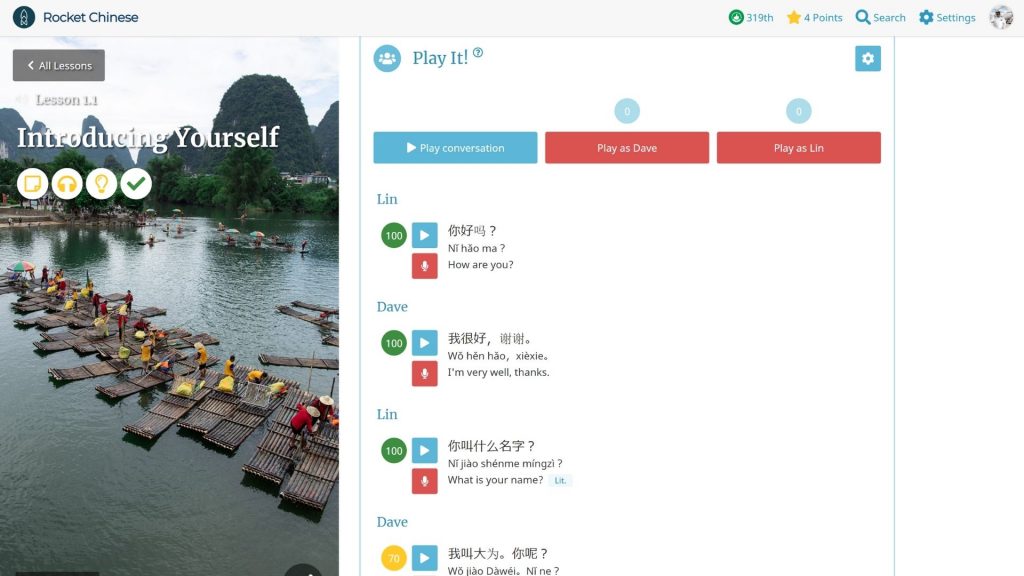
I like the option to record and compare your audio with the native speaker. That’s hands down the best part of the course. The program does grade your speaking ability, but it’s imperfect (as most of these types of things are).
But you can only access this feature on your computer. Even in the mobile web browser or the app, you can’t playback your audio. You can only record it and receive a grade.
That was a big negative for me since this was my favorite feature, but as a mom always on the go, I rarely study on my computer. I almost always use my phone.
Review Activities
The Extra Vocabulary section was helpful as well, and also allows you to listen and record.
Most lessons include about 20 – 30 new words and phrases, although I found that some weren’t the most helpful for beginners starting out.
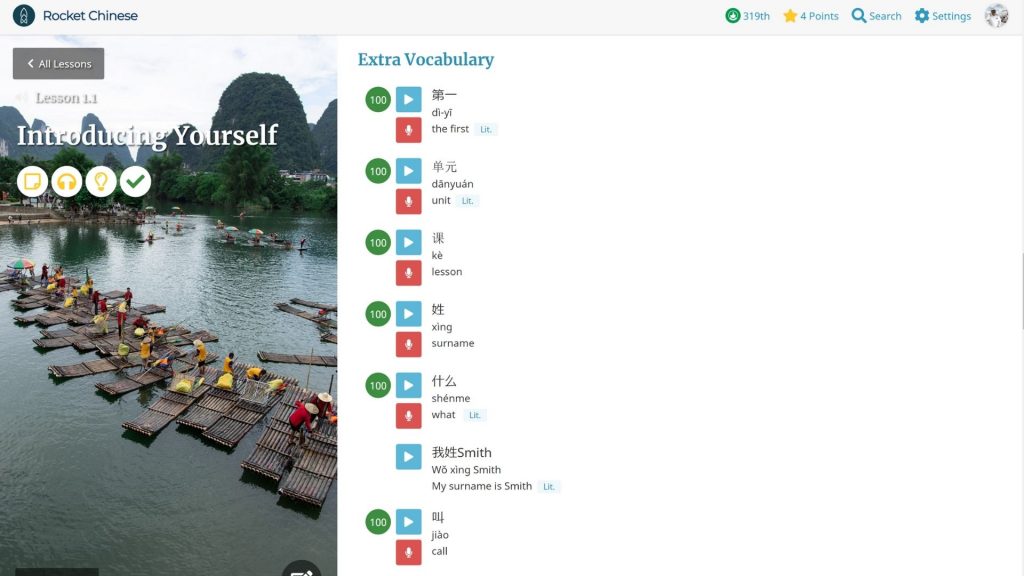
Helpful for learners down the road, yes. But, for instance, learning how to say “first, second, and third” in Chinese before even learning “one, two, three” seemed a bit silly.
The structure of what you learn seems more geared to tourists than learners who want to speak fluently. I didn’t find the content was super helpful in giving me the knowledge I need for conversations right away outside of introductions.
This also brings me to the expert tips. These were so generic and not at all well thought out. The very first lesson’s expert tip is to “think in Chinese.” How can I do that when I don’t know any Chinese yet??
The rest of the review activities were solid, with plenty of chances to study what you learned.
They’re not exciting or very fun, but they’re good for memorization. If you like studying with Anki flashcards, you’ll find these to work well for you.
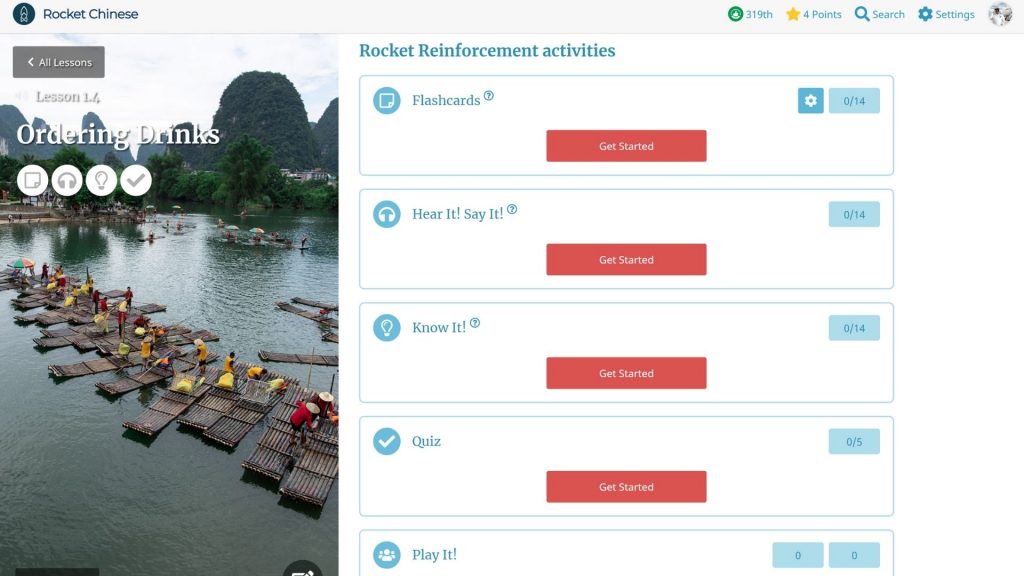
Language & Culture Lessons
In these lessons, you learn cultural insights, grammar, key phrases, and extra helpful vocab.
Honestly, I found these lessons to be the most helpful out of it all.
They’re primarily text-based lessons, written almost like a blog post. They include audio of each word or phrase, and the option to record your pronunciation.
They are quite long, but these are the lessons that have the most helpful words and phrases for beginners.
Most of the cultural insights are quite interesting too. Such as the use of tone vs volume in Chinese, which can be used to express friendliness or distance.
Each lesson still introduces about 20 – 30 new words, sometimes a bit less.
So by the time you finish the lessons in the interactive audio section and the language and culture section, you should know a lot of words already.
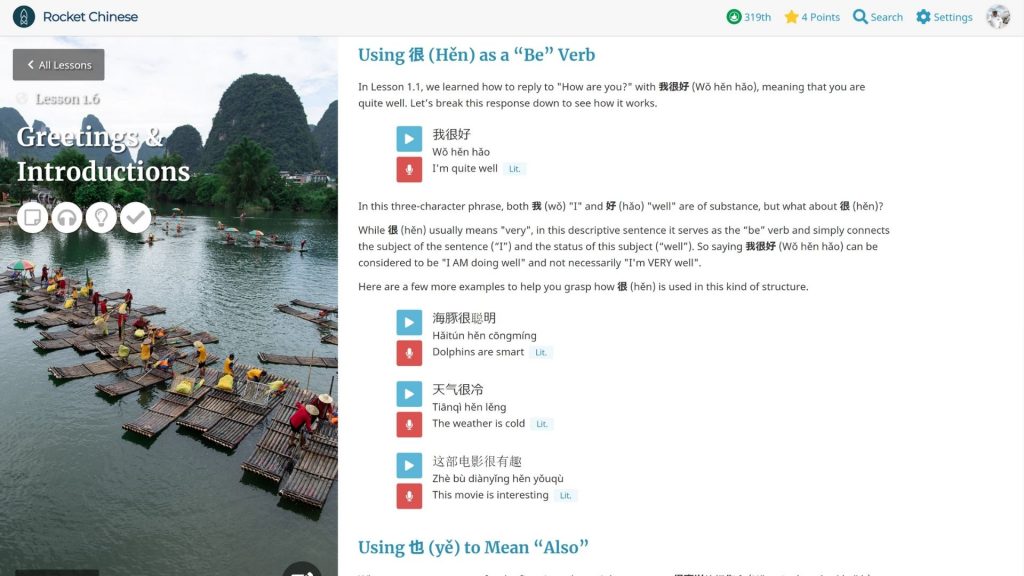
Personally, I felt like it was a lot thrown at absolute beginners. But I still think this is the section where the course shines the most.
It would probably benefit from less text and more video content (or at least video added). That would help break up the wall of text and assist visual learners as well.
Writing Lessons
These lessons are where you learn how to read and write Hanzi.
They start by showing you a character, then teach you the stroke order and have you trace or draw the character yourself to learn it.
You’ll hear the audio of the hanzi, and repeat it, so you learn how to read it (or at least one of its readings).
At the end, there’s a brief quiz.
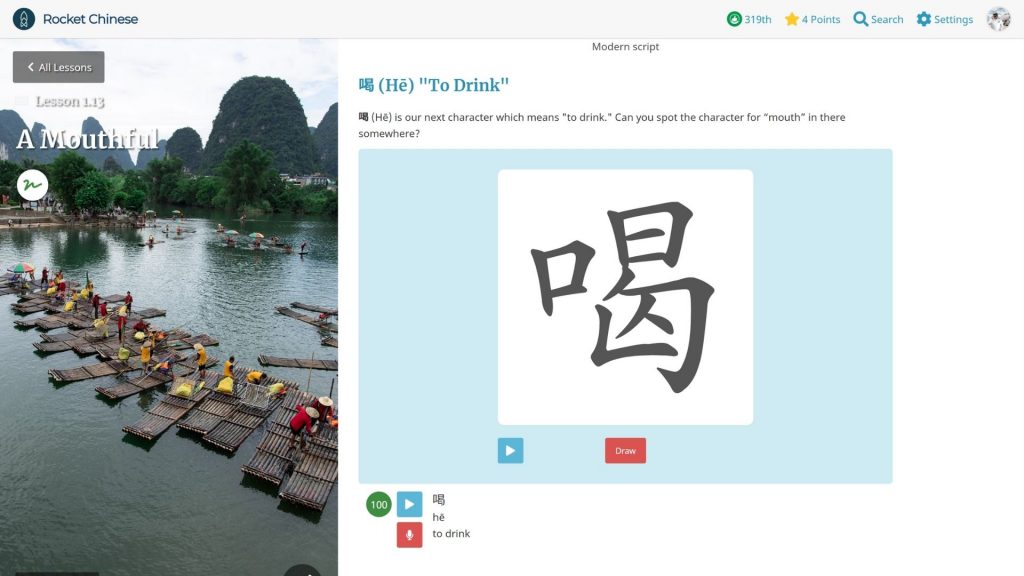
While I think these lessons are pretty solid, there were some questionable things.
For example, as someone who’s been learning kanji in Japanese, I found their explanations of the hanzi to be okay. But definitely not the best way to learn them. Teaching mnemonics rather than the archaic pictographs they came from would’ve been much better, in my opinion.
Besides that, there were some odd choices for the first few hanzi you learn.
For example, in module one, they taught the hanzi for “concave” (凹) and “convex” (凸), neither of which are very common, especially for beginners.
Two lessons letter, they teach you the hanzi for “mouth” (口). That’s fine, that’s a common and simple hanzi.
But then it immediately jumps into much more complex kanji such as “to drink” (喝) and “to blow” (吹). The purpose was to show how one radical or element can be a building block for more complex kanji.
That’s understandable. And, of course, “to blow” isn’t exceptionally hard. And “to drink” is common.
But I know there are definitely easier, more common hanzi that could’ve been taught to build up to this for at least the first module.
Especially since hanzi is hands down the #1 most intimidating thing about Chinese for new learners.
Besides that, some explanations and words weren’t very clear. I still have no idea what the difference is between a morpheme and a character.
So while I think these lessons do an okay, if old-fashioned, job of teaching you hanzi, I sometimes felt like they weren’t well thought-out in their order.
My Experience with Rocket Languages: An Honest Review
So how did I do with Rocket Chinese?
Well… I did okay.
I tested out Rocket Chinese for a few weeks, putting in about 30 min – 1 hr each day.
And while I am starting to get a grip on some of the sounds and language, I wouldn’t say I can speak much at all or feel confident in my pronunciation yet.
And the density of each lesson, right from the start, meant it took me a lot of time to progress very little.
I feel like this course is like a mix of Rosetta Stone’s philosophy and ChineseClass101 (Innovative Languages)’s formula.
And like Rosetta Stone, they take an immersive, slow-and-steady approach. It’s very traditional and relies a lot on immersive listening skills.
I think that could work for some people. But I don’t think it worked well for me.
I don’t learn best by listening and repeating set phrases. I learn best by reading, visuals, and learning to create my own sentences.
That’s my learning style preference, so I definitely feel like learning style makes a difference here.
That said, it was just so painfully slow for me.
The density of each lesson often felt daunting.
I’d dedicate 30 minutes to an hour a day to go through the material, and 30 minutes was for the interactive audio alone. So it’d take me a couple of days to get through just one lesson that only taught a handful of things.
Compared to even Innovative Languages’ similar model, I learned a lot more, a lot faster. Their podcast-style episodes and review materials on their site seem more efficient.
Similarly, when I tried 90 Day Korean with only very basic Korean knowledge, I was able to absorb a lot more, a lot faster.
Those lessons were bite-sized and focused a lot on learning to build your own sentences rather than repeating set phrases.
That was frustrating for me about Rocket Chinese. I felt like I couldn’t dedicate the time to really dig into the material without having to break up each lesson. And I felt like I would forget a lot between lessons because it was a lot of rote memorization.
I think the course could benefit from some changes to the outline of when things are introduced, shorter lessons, and more diversity in activities. Every lesson is more or less the same, which gets tiresome.
All that said, I did learn what I would consider a decent beginning foundation for Chinese, and I do think this course has value for auditory learners.
Rocket Languages Pros and Cons
Pros:
- The app and website are clear and easy to use, with a nice interface and structure.
- It follows 3 levels of Chinese learning, from about a CEFR A1 to B1 level.
- The app focuses a lot on listening and pronunciation, which is great for auditory learners.
- There are lots of review options, from flashcards to pronunciation practice.
- The pronunciation games and ability to compare your voice recording to the native speaker is a great feature.
- The language and culture lessons are insightful and offer a lot of knowledge in each lesson.
- It’s a clear, structured course that will help guide you along in your Chinese learning.
Cons:
- The audio lessons are very slow, often awkward, and very long for beginners.
- It’s quite repetitive, which gets boring fast.
- The lessons don’t always flow logically and a lot of early vocab is not helpful or immediately useful to beginners. There’s a lot of wasted effort.
- Even though the emphasis is on listening and pronunciation, I found the explanation of pronunciation to be lacking.
- There isn’t a lot of diversity in the learning: each lesson is more or less the same, with the same review activities and outline.
Rocket Chinese Review Summary: 3 Stars, a Decent Course with Better Options Out There
Okay, I was pretty hard on this course.
But I do honestly think it would work for some people.
Namely, those who prefer traditional, slower-paced, immersive style learning (like Rosetta Stone), and auditory learners. That just isn’t me.
And if I were to pick an audio-based course, I would probably choose ChineseClass101 for a similar price point.
I do think the course has value, but I think there are better options out there for the price and time put in.
So I’m giving it 3 stars because it’s a decent course… There are just better options.
Editor’s note: Another Fi3M reviewer found Rocket Languages better for learning Latin-related languages! You can read Alice’s review over here.

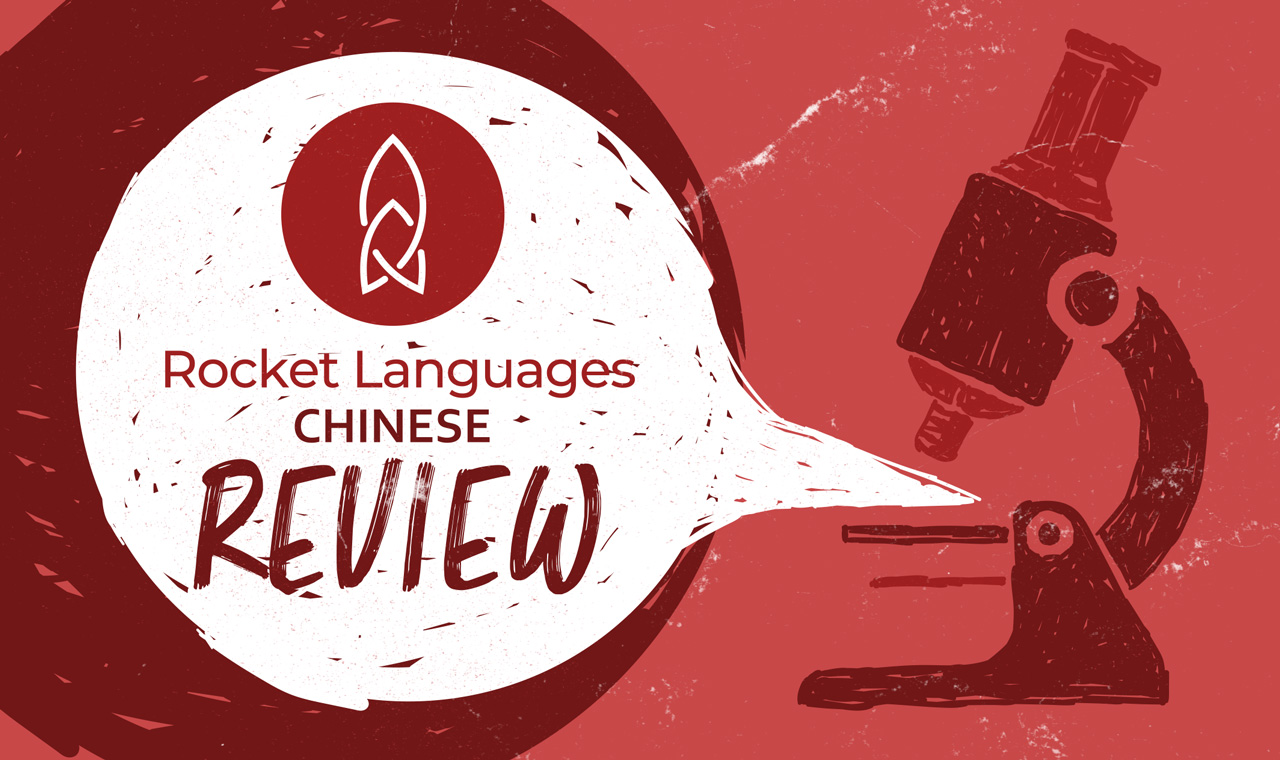


Social